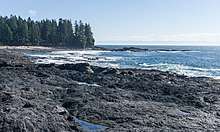Juan de Fuca Provincial Park
Juan de Fuca Provincial Park is a provincial park in British Columbia, Canada. The park was created in 1996 by combining the former China Beach Provincial Park, Loss Creek Park, Parkinson Creek Park and Botanical Beach Park and the trail connecting them into one park.[1] It is the location of the majority of the Juan de Fuca Marine Trail, which is the southern complement of the West Coast Trail within Pacific Rim National Park Reserve.
| Juan de Fuca Provincial Park | |
|---|---|
 A section of trail in Juan de Fuca Provincial Park | |
| Location | Vancouver Island, British Columbia, Canada |
| Nearest city | Port Renfrew Sooke Victoria |
| Area | 1,528 ha (5.90 sq mi) |
| Established | April 4, 1996 |
| Governing body | BC Parks |
History
The current park was established April 4, 1996.[2] The region was recognized as biologically significant, and Josephine Tilden of the University of Minnesota installed the first marine research station in the Pacific Northwest at Botanical Beach in 1901.[3] The University of Minnesota maintained a research station here for five years, but they left in 1906. Conway MacMillan resigned from the University of Minnesota after the university refused to take ownership of land in a different country. After the departure of the University of Minnesota, the University of British Columbia, University of Washington, Simon Fraser University, and the University of Victoria have done research in the area.[3] Prior to the establishment, there were several parks in the area protecting what is now within the boundaries of the park.
Botanical Beach Provincial Park was a 351 hectares (870 acres) park that excluded the area encompassing the Mill Bay trail today at the northernmost reach of Juan de Fuca Provincial Park. At the time of creation, the park was 76% natural environment, with plans for complete restoration of the entire park. This included 231 hectares (570 acres) of land and 120 hectares (300 acres) of foreshore.[4] The park was established to encourage education and research in the area. A nature reserve was established in 1961, and expanded in 1966 to include 47 hectares (120 acres) and 2,200 metres (2,400 yd) of shoreline. The initial proposal for the park was investigated in 1981, with the final park was established in 1989 as a Class A park.[4] Access to the park has been possible by the current gravel road since prior to its establishment.[3]
Loss Creek Provincial Park was a 21 hectares (52 acres) Class A park created on June 29, 1959 at the bridge over the creek of the same name. It was the closest park to Sombrio Point prior to the existence of the current park, though it was undeveloped.[3]
China Beach Provincial Park was the best developed of the Class A parks brought together, at 61 hectares (150 acres). It was created on January 4, 1967, with a day-use area and vehicle-accessible campground.[3] The creation of the original China Beach Provincial Park came about in a trade between the provincial government and a forestry company. By allowing logging in the Bedwell Valley of Strathcona Provincial Park the company agreed to hand over the land for China Beach.[5]
While Sombrio Beach and Mystic Beach were not part of a provincial park prior to the establishment of Juan de Fuca Provincial Park, it was a major recreation point for locals with rudimentary trail built directly from the highway to the beaches.[6]
Geography
The park has an area of 15.28 km². The Juan de Fuca Marine Trail was originally part of a lifesaving trail that serviced this area, known at the time as the Graveyard of the Pacific. It has been upgraded and maintained over the years and is now a very popular 47 km hiking trail, very similar to the West Coast Trail in Pacific Rim National Park.
The park is located 35 kilometres west of Sooke and 36 kilometres east of Port Renfrew, British Columbia.
Conservation

The primary role of Juan de Fuca Provincial Park is to protect a highly scenic and unique shoreline area between Sooke and Port Renfrew along the Strait of Juan de Fuca. The park encompasses a wide spectrum of natural values from forests to wildlife that must be protected and managed to reflect the purpose for which it was created. Juan de Fuca Provincial Park provides a protected habitat and natural corridor for many larger species of west coast mammals such as cougar, deer, black bear, wolf, otter, seal and sea lions. Red, purple and orange starfish and sea urchins, white gooseneck barnacles, blue mussels and green sea anemones and sea cucumbers only begin to hint at the colourful spectrum of intertidal life thriving here.
Recreation
The following recreational activities are available: vehicle accessible and wilderness camping, hiking, picnicking, interpretive walks, swimming, canoeing and kayaking, fishing, SCUBA diving, windsurfing, and surfing. The beach is best visited at low tide.
See also
- List of British Columbia Provincial Parks
- List of Canadian provincial parks
- Juan de Fuca Trail
References
- "Juan de Fuca Park". BC Geographical Names.
- "Botanical Beach Provincial Park". Port Renfrew.com. Retrieved 17 October 2019.
- The B.C. Parks Explorer (First ed.). Vancouver: Whitecap Books. 1986. p. 59. ISBN 0-920620-63-9.
- Master Plan for Botanical Beach Provincial Park. Victoria, BC: BC Parks, British Columbia Ministry of the Environment. August 1992. p. 42. ISBN 0-7726-1622-1.
- Anderson, James D. (2011). British Columbia's Magnificent Parks: The First 100 Years. Maderia Park, BC: Harbour Publishing. p. 102. ISBN 978-1-55017-507-3.
- Waddell, Jane (1979). Hiking Trails I (8th ed.). Victoria, BC: Outdoor Club of Victoria. pp. 44–45. ISBN 0-9690401-0-5.
External links
| Wikimedia Commons has media related to Juan de Fuca Provincial Park. |
| Wikivoyage has a travel guide for Juan de Fuca Provincial Park. |